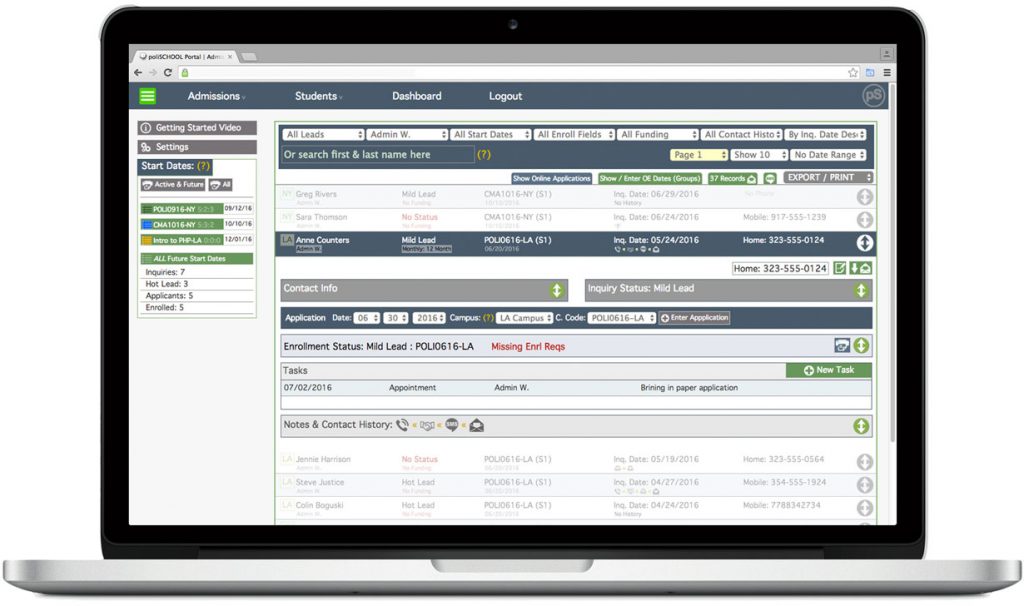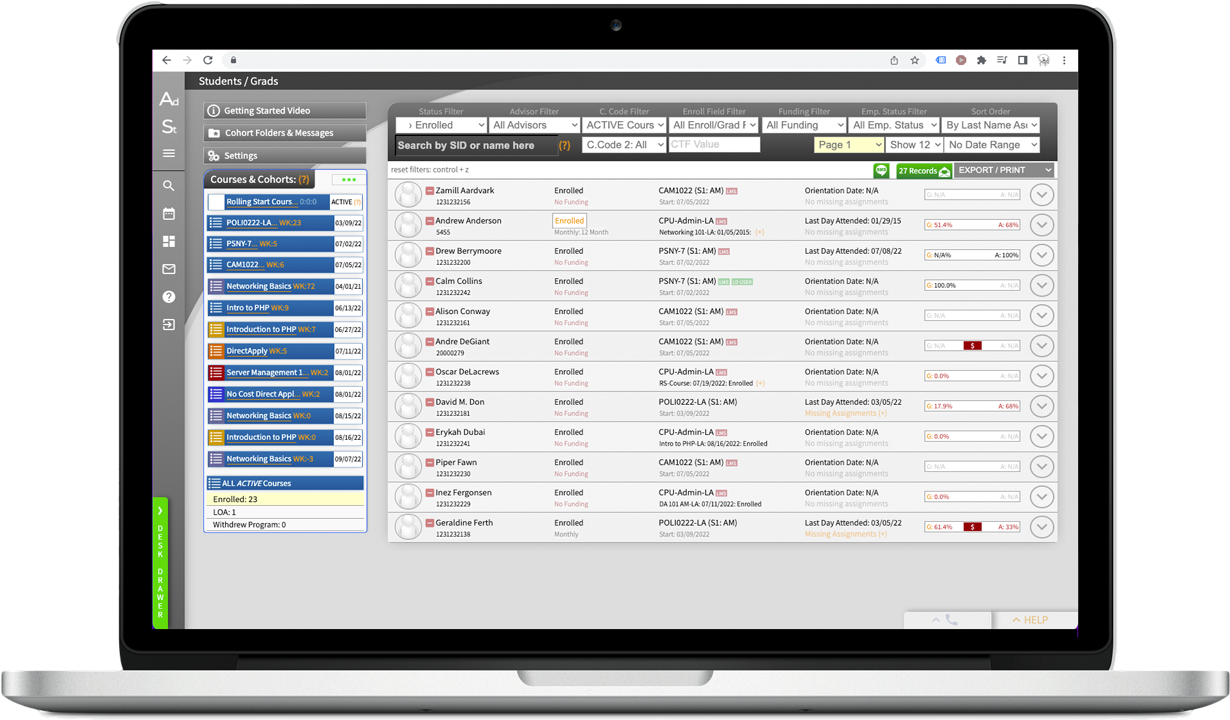
Admissions software is a crucial tool for educational institutions, streamlining the process of managing student applications and enrollment. This software provides an efficient platform for collecting, organizing, and reviewing application materials, ensuring compliance with statutory and regulatory requirements. By automating tasks such as document verification and communication with prospective students, admissions software enhances accuracy and saves time for staff. It also facilitates better decision-making by providing data-driven insights into applicant qualifications and trends. Overall, admissions software supports schools in maintaining a transparent, effective, and student-centered admissions process.
Factors To Consider When Choosing Student Enrollment Software
The Importance of Speed in Enrollment Processes
In today’s fast-paced world, speed is of the essence, especially in the enrollment processes at career and trade schools. Students and educational institutions alike benefit from quick, efficient processes that meet the high demand for skilled workers. The sooner students are enrolled, the sooner they can begin their journey toward a fulfilling career.
To achieve this speed, schools need to invest in modern technology solutions like Student Information Systems (SIS) and Customer Relationship Management (CRM) systems. These systems streamline the enrollment process, allowing students to apply and receive feedback swiftly. Schools can use platforms like PoliSchool to enhance their enrollment systems, ensuring that they can accommodate the growing number of applicants without delays.
Fast enrollment processes also help in maintaining the enthusiasm and motivation of prospective students. When students encounter lengthy and cumbersome procedures, they may lose interest or seek alternatives. Therefore, schools must prioritize efficient systems that keep students engaged and eager to start their educational journey.
Maintaining Compliance in Enrollment
Compliance is a critical factor in the enrollment process at career and trade schools. Schools must adhere to various regulations and standards to ensure they provide a safe and equitable educational environment. Failing to comply with these requirements can lead to legal issues and damage the school’s reputation.
To maintain compliance, schools need to implement robust systems for tracking and reporting student information. This includes collecting accurate data on student demographics, academic progress, and financial aid eligibility. Schools should also have procedures in place to ensure the security and confidentiality of student records.
Furthermore, schools need to stay updated on changes in regulations and adjust their processes accordingly. Regular training for staff and administrators is essential to ensure everyone understands their roles and responsibilities in maintaining compliance. By prioritizing compliance, schools can protect their students and institutions while providing high-quality education.
Gathering and Storing Required Documents
One of the most time-consuming aspects of the enrollment process is gathering and storing the required documents from applicants and students. These documents often include transcripts, identification, proof of residency, and financial aid forms. Ensuring that these documents are complete and accurate is crucial for a successful enrollment process.
To streamline this process, schools can leverage digital tools and platforms. Online portals allow students to upload their documents securely, reducing the need for physical paperwork and in-person meetings. Schools can also implement document management systems that organize and store these files efficiently.
Here are some steps schools can take to improve document management:
- Create a checklist: Provide students with a detailed list of required documents to ensure they submit everything needed.
- Offer online submission: Allow students to upload documents through a secure online portal, minimizing the risk of lost or misplaced paperwork.
- Implement document tracking: Use software to track the status of submitted documents and alert students of any missing items.
- Ensure data security: Protect student information with encryption and access controls to prevent unauthorized access.
By adopting these practices, schools can simplify the document-gathering process, ensuring a smooth and efficient enrollment experience for students.
Managing Fees and Financial Transactions
Fee management is another vital aspect of the enrollment process at career and trade schools. Schools must have clear and transparent systems for managing tuition fees, deposits, and other financial transactions. This not only helps in maintaining financial stability but also builds trust with students and their families.
To manage fees effectively, schools can implement the following strategies:
- Provide clear information: Offer detailed information about tuition fees, payment plans, and deadlines to students and their families.
- Offer multiple payment options: Allow students to pay fees through various methods such as credit cards, bank transfers, or online payment platforms.
- Implement a payment tracking system: Use software to track payments, send reminders for upcoming deadlines, and generate receipts for students.
- Offer financial aid guidance: Provide resources and support to help students navigate financial aid options and scholarship opportunities.
By managing fees efficiently, schools can ensure that students understand their financial obligations and have access to the resources they need to succeed.
Effective Communication Between Students and Staff
Communication is key to a successful enrollment process. Schools must establish clear channels of communication between students and staff to ensure that information is exchanged effectively and nothing gets lost in the process. Miscommunication can lead to confusion, delays, and frustration for both students and staff members.
To facilitate effective communication, schools can implement the following practices:
- Establish clear communication channels: Use email, phone, messaging apps, and online portals to communicate with students and provide them with timely updates.
- Assign enrollment advisors: Designate staff members to serve as enrollment advisors, providing personalized support and answering questions from prospective students.
- Organize orientation sessions: Offer orientation sessions to introduce students to the school’s policies, procedures, and support services.
- Provide regular updates: Keep students informed about the status of their application and any additional steps they need to take.
By prioritizing communication, schools can ensure that students feel supported and informed throughout the enrollment process, leading to a more positive experience for everyone involved.
FAQs
What documents are typically required for enrollment at a career or trade school?
Documents commonly required include transcripts, identification, proof of residency, and financial aid forms. Schools may also request additional documents depending on their specific requirements.
How can schools ensure compliance during the enrollment process?
Schools can ensure compliance by implementing robust systems for tracking and reporting student information, staying updated on changes in regulations, and providing regular training for staff.
What are some effective strategies for managing fees and financial transactions?
Schools can manage fees effectively by providing clear information about tuition, offering multiple payment options, implementing payment tracking systems, and offering financial aid guidance.
Why is speed important in the enrollment process?
Speed is important because it allows students to begin their education more quickly, maintaining their enthusiasm and motivation. Efficient processes also help schools accommodate the growing number of applicants.
How can schools facilitate effective communication between students and staff?
Schools can facilitate communication by establishing clear channels, assigning enrollment advisors, organizing orientation sessions, and providing regular updates to students.
What role does technology play in the enrollment process?
Technology streamlines the enrollment process by automating tasks, reducing paperwork, and enhancing communication. Platforms like poliSCHOOL offer tools to manage applications, track documents, and maintain compliance.
Conclusion
Enrolling students at a career or trade school involves navigating a complex process with many moving parts. By focusing on speed, compliance, document management, fee handling, and communication, schools can create an enrollment experience that is efficient and student-friendly. Leveraging technology and streamlined systems like those offered by poliSCHOOL can further enhance the process, ensuring that schools can accommodate the needs of their students while maintaining high standards of education and compliance.
The Elephant In The Room...
Yep! I hear you! You’re thinking “Hold Up! This is an article about tips for choosing the right CRM / SIS system written by a company that makes CRM / SIS systems?!? They got some nerve!”
First… you’re right! We do have some nerve! But it’s (…dare I say?) “well-earned” nerve!
Everyone who works at poliSCHOOL has had experience with vocational schools – both teaching in them as well as working as administrators for them. It’s a different world than more traditional forms of education especially if you are a small to medium sized school working on scaling up.
We know the rigors of enrolling students into a variety of programs: first using Excel spreadsheet after Excel spreadsheet when you first open and then cobbling together more sophisticated services using a variety of programs both online and off to streamline the process as interest in your program makes spreadsheets unsustainable. We’ve all been through the “freak-out’s” starting the accreditation process and worrying about what state and federal accreditors will think of your storage process or what they’re going to require you to upgrade system wise and can you meet those upgrades without breaking your bank.
Our nerve comes from our experience in going through that for years and realizing that there was no guidance on how to navigate such turbulent and ever-changing waters… especially in the digital age when there seems to be so many choices.
But there’s another reason we’re writing this article: choosing a new CRM / SIS system for your trade school is kind of like choosing your new home (or personal trucking rig, if you’re a trucking school…) – it’s a long-term commitment! Most accreditors require your system maintain records for at least 5-7 years after students graduate. And since most systems also offer record storage, you’re talking about a serious relationship between your trucking school and that software!
If you’re using it right you’re living in your CRM/ SIS system daily, depending on it, and comfortable about all the features it offers! Kind of like a home.
And just like every house is the perfect home for everybody… not every CRM / SIS system is right for every school! We definitely encourage you to take a look at our software (seriously! Feel free to sign up for a demo!) but if it’s not right, it’s not right!
But take these tips with you as a guide to figuring out what you’re looking for in the perfect system. It’s out there and whether it’s our platform or anothers’, we want to empower you in finding your future home.








